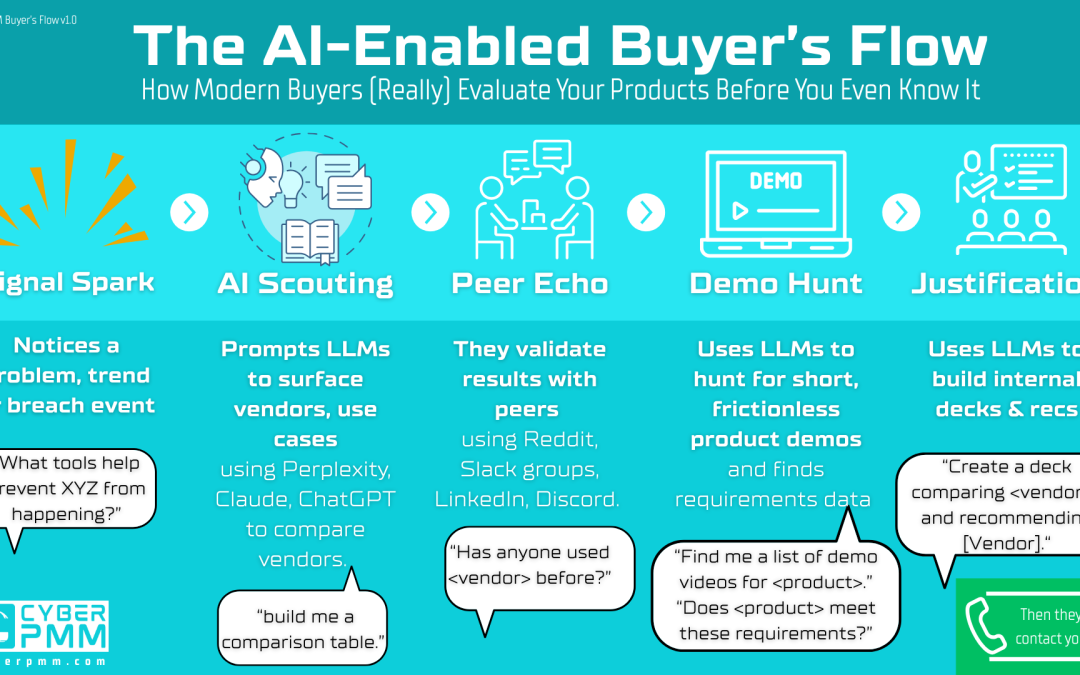It’s time to revise the old “buyer’s journey map” mindset which was created before buyer’s were AI-enabled. Welcome to the era of the AI-Enabled Buyer’s Flow.
The rules that once shaped a buyer’s flow when evaluating enterprise software are changing fast and PMMs are stuck between outdated methods and an AI-enabled world. To generate value, we used to produce assets that helped buyers find, understand, and ultimately purchase our product. Today, buyer’s are using LLMs to find information, not pretty content, so we have to adapt.
In the traditional PMM playbook, being a creator meant executing against a well-defined buyer’s journey map. You started with buyer personas, defined their pain points, mapped those to stages of a buyer’s journey, and then filled the gaps with content. The strategy was clear: guide your buyer from education to solution to selection. Life was so simple then.
You likely used a SiriusDecisions-style framework from a decade ago (fuzzily pictured below, video here), mapping content to stages by persona.
The Good Old Days
The logic went something like this:
- Loosen Status Quo → Thought leadership and industry trends
- Commit to Change → Benchmark data and case studies
- Explore Solutions → Product overviews, demos, comparisons
- Commit to a Solution → Webinars, technical diagrams
- Justify the Decision → ROI calculators, cost modeling
- Select Provider → RFP support, pricing, documentation
And as a good PMM, we created product content accordingly.
- Educational blogs and thought leadership for Stage 1 and 2
- Solution briefs, webinars, demos and comparison guides for Stage 3 and 4
- Testimonials, ROI calculators and procurement checklists for Stage 5 and 6
In cybersecurity, this journey played out across complex buying committees:
- SOC analysts exploring tools hands-on
- SOC directors prioritizing operational fit
- CISOs evaluating risk and business alignment
- Finance teams checking on pricing, ROI and cost
We used persona prioritization frameworks to figure out who to focus on first. Then we mapped content by persona and stage: white papers for CISOs, demo videos for analysts, and dashboards or use cases for the director-level buyer. We thought deeply about format—what works best for whom—and tried to produce what we could, often with limited time and budget.
The traditional model helped many Type-A PMMs succeed. It gave us rules and structure. And it still has some contextual value, like when we visit museums and ponder the simpler lives of those before us.
But here’s the hard truth: buyers don’t move through content the way they used to. They don’t follow your linear journey. They don’t rely on your website. They don’t wait for your nurturing sequence. And increasingly, they aren’t even reading your content—they’re asking AI to summarize it.
The buyer’s journey has been re-written. It’s an AI-enabled buyer’s flow, and it’s as controllable.
Here’s a new, modern Buyer’s Flow framework that reflects how buyers now research, evaluate, and decide — powered by AI, automation, and peer ecosystems:
The AI-Enabled Buyer’s Flow

🟠 Signal Spark
The journey begins when a buyer becomes aware of a problem, disruption, or opportunity. It might be a data breach, a compliance change, or inefficiencies that can’t be ignored. But instead of visiting a vendor website or talking to a salesperson, they turn to AI now. They enter prompts like, “What tools help detect insider threats?” or “List the best tools that reduce alert fatigue in a SOC.” This is no longer passive browsing—it’s intent-rich, problem-first, and immediate. The AI becomes the buyer’s first touchpoint, framing how they think about solutions before they even know your brand exists.
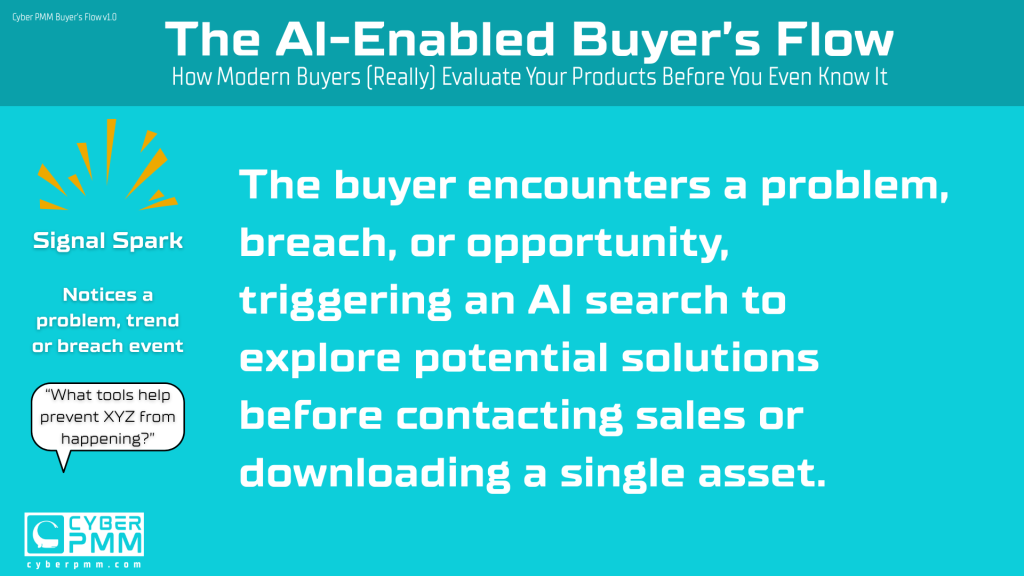
🔵 AI Scouting
Armed with a problem, the buyer uses AI tools—ChatGPT, Perplexity, Claude—to identify possible solutions. They don’t Google “best SOAR platforms” as much anymore. Instead, they ask AI to compare tools by use case, budget, or capability. They get back summaries, pros and cons, even suggested vendors. LLMs are effectively curating their first vendor list. If your messaging isn’t AI-parsable, you may not show up at all. The buyer builds confidence in the options without talking to anyone. It’s quiet. It’s anonymous. It’s fast. Traditional marketing touchpoints like white papers and SEO pages are being leapfrogged—this is the new shortlisting engine.
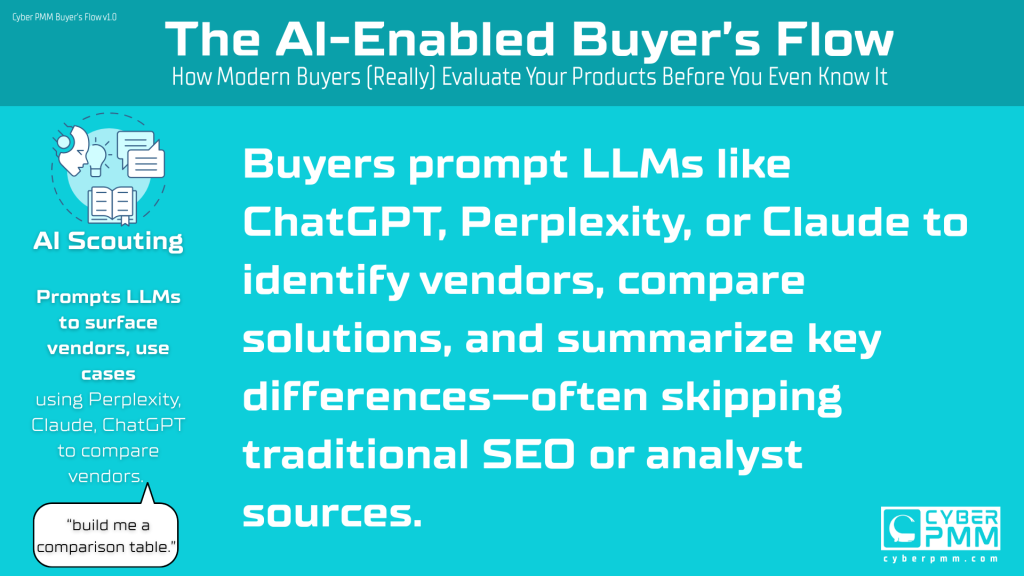
🟢 Peer Echo
After narrowing their list through AI, buyers look to validate what the machine said with real humans. They go to peer channels like Slack communities, Reddit subs, Discord groups, and LinkedIn DMs. They ask, “Has anyone used [Vendor]?” or “Which platform has the better UI?” This dark social phase is where trust gets built. The buyer wants to hear from practitioners, not polished marketing. One negative post or lukewarm review can knock you off the list. This is where customer advocacy, social proof, and word-of-mouth matter most. If your customers aren’t talking about you, your product might as well not exist.
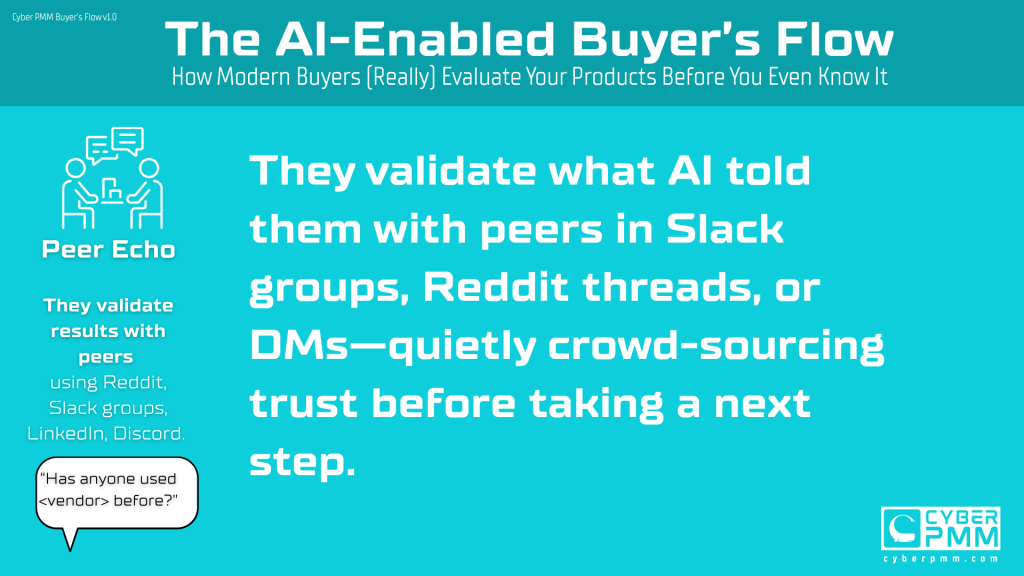
🟣 Demo Hunt
Now the buyer wants proof. They’re not scheduling a discovery call. They’re prompting ChatGPT for demo videos or watching product walkthroughs on YouTube. They may use AI to summarize demo transcripts or ask for side-by-side comparisons. “Does Vendor A integrate with my tech stack?” “Can Vendor B do real-time alert suppression?” Your content must be frictionless, specific, and brief. No filler intros. No vague promises. No fluff. Just real use cases shown clearly. This is where PMMs will win or lose. If your product’s value can’t be shown quickly—without a sales assist—you may never make it to the conversation.
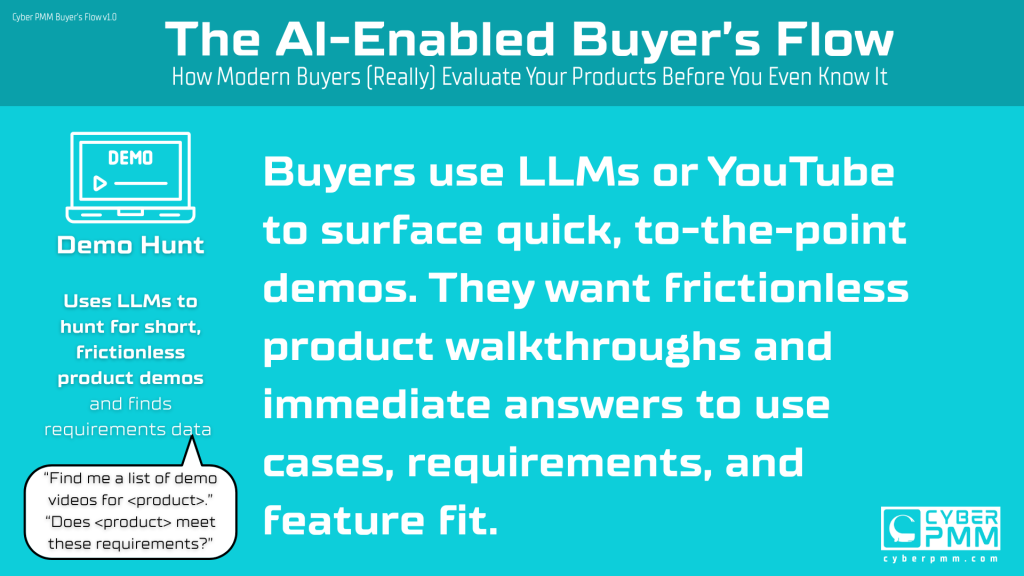
🔴 Justification
The buyer is leaning in. They’ve seen enough to form a preference. But before reaching out, they have to convince internal stakeholders. Do they pull a deck from your site? Nope. They ask AI to build one: “Create a slide deck comparing Vendor A vs Vendor B.” They use LLMs to draft internal justification memos, risk-benefit summaries, and ROI models. If your public content is clear, structured, and rich with talking points, it becomes ammo for that deck. If not, the LLM fills in the blanks—and it might favor your competitor. You win by making your buyer look smart internally.
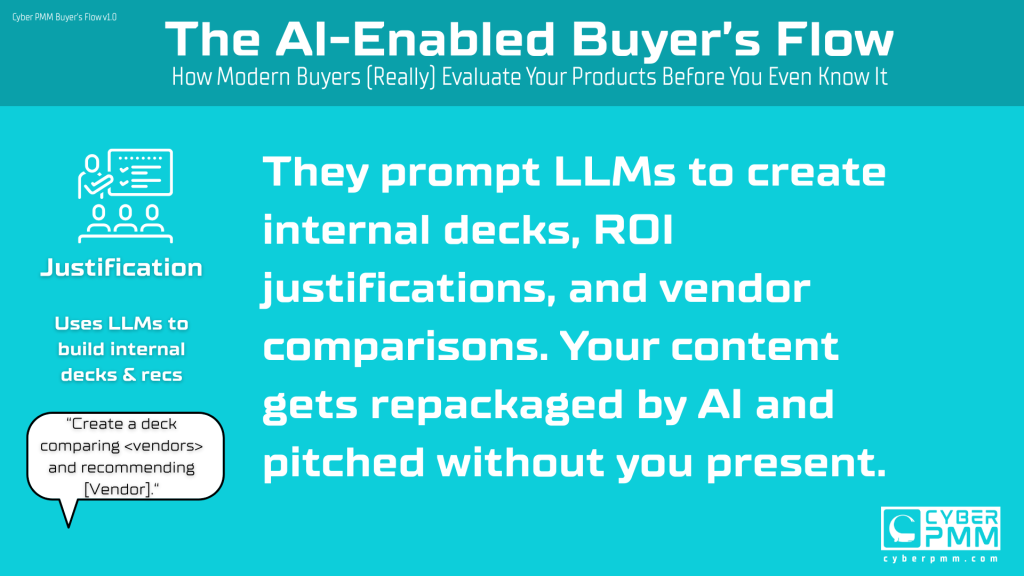
🧠 Wrapping Up: The Shift No One Told You About
The buyer’s journey didn’t evolve — it jumped tracks. AI now mediates how problems are recognized, how vendors are surfaced, and how internal decisions are made. Buyers aren’t browsing your blog, they’re summarizing it. They’re not attending your webinars, they’re skipping to the AI-clipped highlights. They’re not waiting to be nurtured — they’ve already shortlisted.
If you’re still building content for a linear funnel, you’re not just behind — you’re invisible.
This new AI-Enabled Buyer’s Flow isn’t hypothetical. It’s already happening. Quietly. Quickly. And in most cases, without you knowing.
🔜 Up Next: How PMMs Must Adapt
In Part 2, we’ll break down how anyone bringing complex tech to chaotic markets should operate inside this new framework — including:
- What content you must create now (and what to stop making)
- How to structure assets so they perform inside AI tools
- Where to show up outside your owned channels
It’s not about doing more things. It’s about doing things different.
👉 Subscribe below — this next part is where things get tactical.
You might also like: The 10 Camps of AI Innovation

